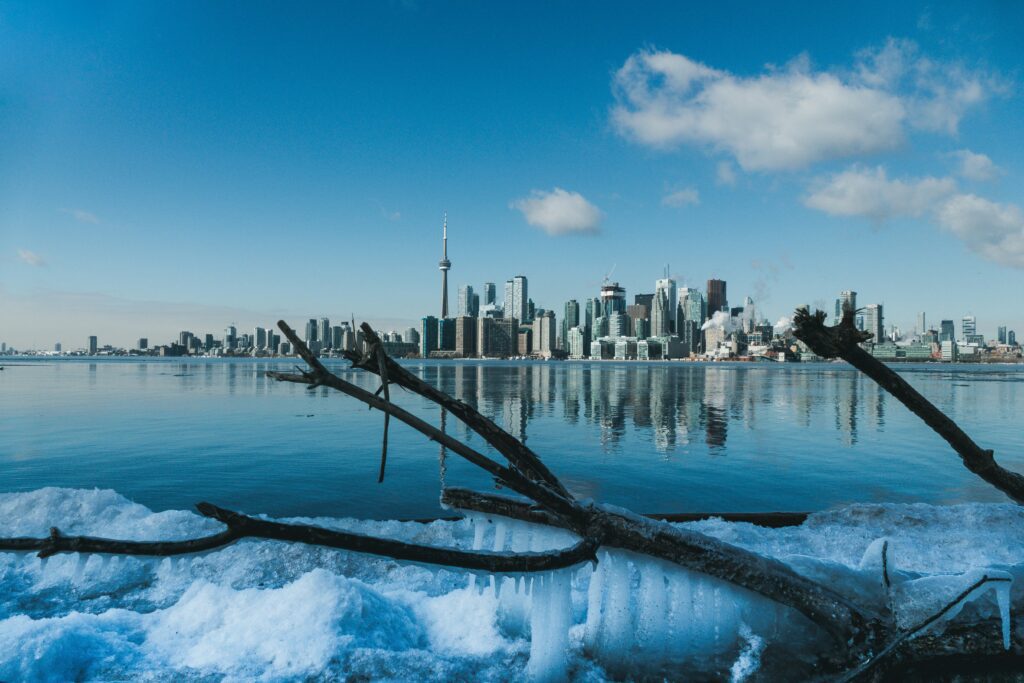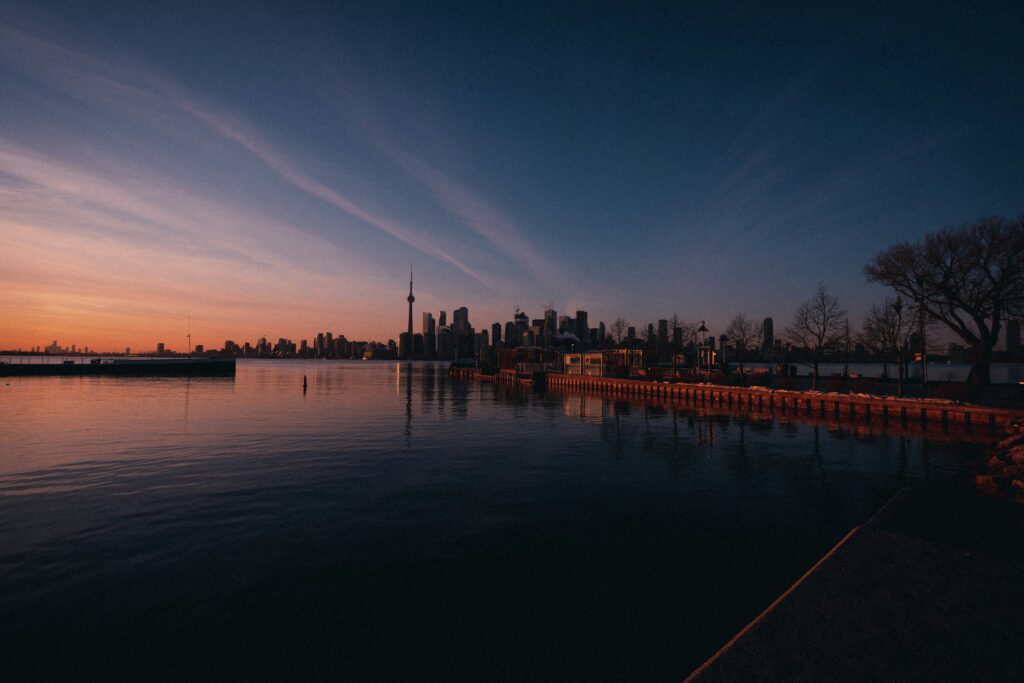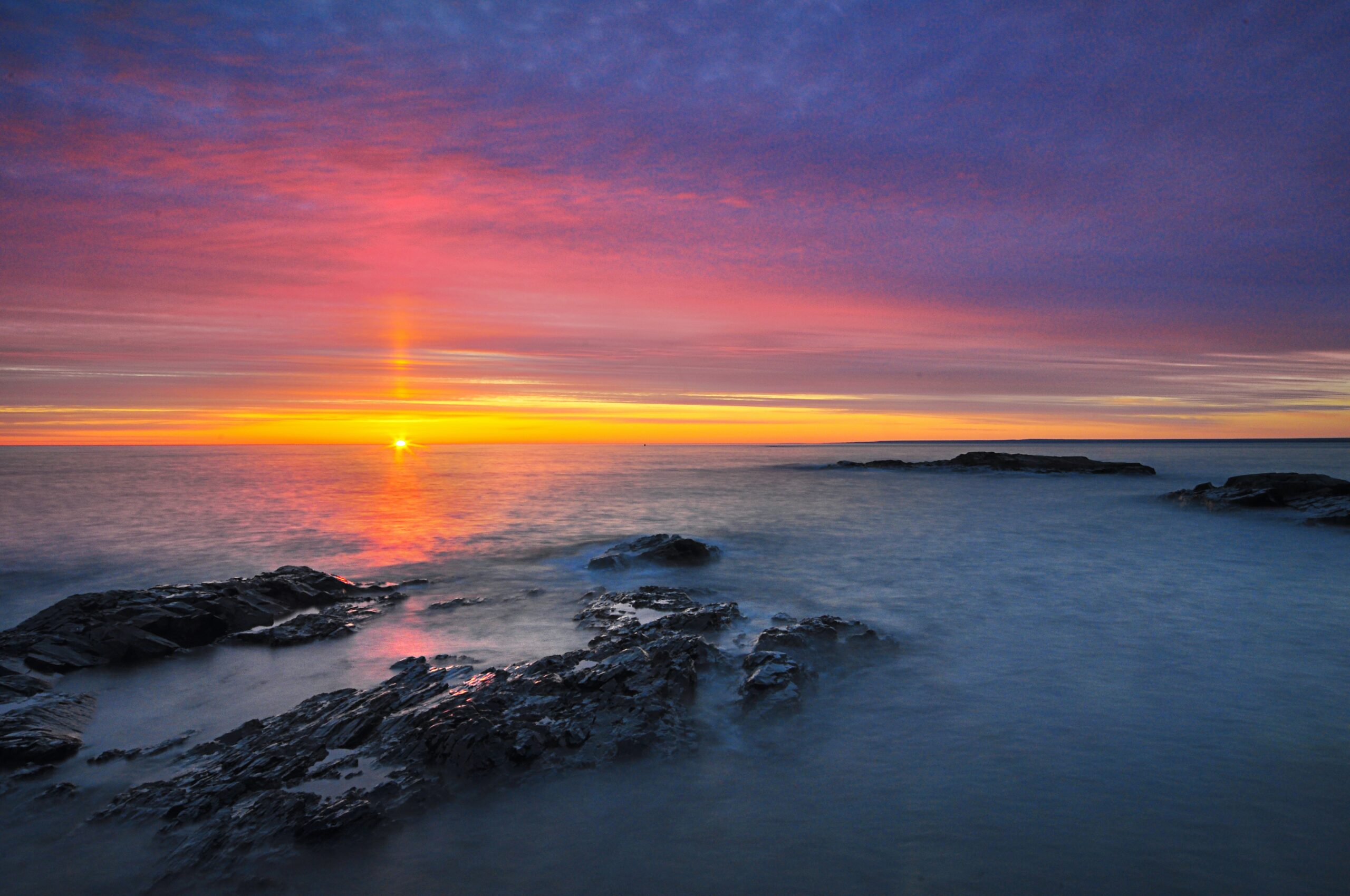Overview of the Lake Ontario’s Seasons and Climate
As someone who lives in Ontario, knows the lake quite well and travels through the region, these first hand accounts should be helpful for you, especially if you’re planning a trip to the region, be it Toronto, Muskoka or Niagara Falls.
Lake Ontario and its surrounding environs truly captivate with four distinct seasons offering their unique draw. Ontario’s weather patterns and significant weather events play a pivotal role in your experience, whether you’re planning to sail on the majestic Great Lakes or explore the thundering Niagara Falls. So, when is the best time to visit Lake Ontario?
Typical Weather Patterns
Spring (March – May):
- Temperatures: Warming trends start in March, with an average low of 32°F (0°C) and an average high of 49°F (9.5°C). You might get the odd “hot day” like we had this week, with temperatures reaching mid to high 20s, as high as 29°C.
- Precipitation: It’s a wet season with frequent rain, preparing the land for vibrant spring blooms. Hot days suck up the water from the many lakes in the region, most notably Lake Ontario, Simcoe, and Muskoka, causing extreme downpours for hours after good weather days.
Summer (June – September):
- Temperatures: Comfortably warm, Ontario sees an average low of 59.6°F (15.3°C) and a high around 78.3°F (25.7°C) in July.
- Activities: Best time for outdoor activities, including visiting the Great Lakes and Niagara Falls.
Fall (September – November):
- Transformation: As September arrives, leaves change, showcasing a riot of colors, particularly vivid along the St. Lawrence River.
Winter (December – February):
- Snow & Cold: Brace for chilly weather! Lake-effect snow is common near the Great Lakes, especially Erie and Ontario.
Significant Weather Events
- Lake-Effect Snow: Most prominent during late fall and winter months, this phenomenon can lead to significant snowfall amounts, particularly along the shorelines of Lake Ontario.
- Spring Thaw & Erosion: With spring’s warmer weather, watch for the thaw and its subsequent impact on regions such as the St. Lawrence River, which can lead to erosion concerns.
So go ahead, chart your visit according to the sights you yearn to see and the experiences you’re itching to have. Remember, the weather sets the stage, and in Ontario, each season plays its part to perfection.
Best Time to Visit Lake Ontario: Peak Season

You know how it feels when you hit the sweet spot of a destination’s calendar? That’s the peak season for Lake Ontario! It’s when the buzz of activities is at its highest, and boy, isn’t that the time to soak up the sun and get those reels spinning?
Time Frame
May through September marks the period when Lake Ontario transforms into a hub of excitement. Whether you’re an early bird eyeing that perfect catch at dawn, or you love the late evening calm as the sun dips, these months are ideal.
- Fishing: Grab your gear from May to September, especially if you’re after salmon or bass.
- Boating & Swimming: Summer days mean clear skies, and from June to August, boating and swimming are top-notch activities.
- Summer Attractions: Don’t miss the array of other summer perks by the lake—festivals, open-air events, and more.
Benefits
When you visit during these peak months, the benefits are as clear as the lake on a calm day.
- Great Weather: Sunshine and warmth—perfect for outdoor escapades.
- Activity Galore: You’re in for the best fishing, boating, and swimming experiences.
- Less Pollution: Summer efforts often mean cleaner waters. Who wouldn’t want that?
Drawbacks
But, here’s the catch—no pun intended! Peak season brings a few hurdles along the way.
- Crowds: Expect company. Lots of it. Popular spots could get pretty busy.
- Higher Costs: Demand skyrockets, and so might the prices for accommodations and tours.
Off-Peak or Shoulder Season

So, you’re thinking about visiting Lake Ontario but don’t fancy the summer crowds? Let’s talk about the overlooked gem of travel timing—the shoulder season!
Time Frame
When exactly is the off-peak period for Lake Ontario? Traditionally, this means the months right before and after the bustling summer season. Mark your calendar for the early September days, extending into the crisper air of late fall.
Benefits
Let’s dive into why these months might just be your golden ticket:
- Budget-Friendly: Who doesn’t like saving some cash? During the off-peak, your dollars will stretch further as you’ll often find lower prices on accommodation and activities.
- A Serene Escape: If a peaceful retreat is what you’re after, these are the months to find fewer tourists and more quiet moments by the water.
- September’s Gifts: For example, a September visit might bless you with both warmer water temperatures and fewer folks to share the view with.
Drawbacks
Of course, every rose has its thorn:
- Predicting Weather: The weather can be a tad unpredictable; pack a variety of clothes to be ready for anything Mother Nature throws your way.
- Limited Availability: Some tourist services may scale back operations, so check ahead for the availability of tours, rentals, and facility hours.
Low or Off-Season

When thinking of Lake Ontario, imagine the quiet serenity of the water during the time when fewer tourists dot the shores. That’s the off-season for you—more calm and less flurry.
Time Frame
The low season at Lake Ontario typically runs from late fall through early spring—October to April. You’ll find that the lake transforms as the leaves shift colors and the first frost kisses the ground.
Benefits
- Tranquil Atmosphere: You can enjoy the peace that comes with fewer visitors.
- Economic Advantage: Lodgings may be less expensive and easier to book.
- Local Interaction: Engage more authentically with residents when things are less hectic.
- Unique Experiences: Imagine ice fishing or capturing the silent beauty of a snowy shore.
Noteworthy: The weather during these months can be quite chilly, with temperatures often sitting below freezing, so pack warmly!
Drawbacks
- Cooler Weather: If you’re not a fan of bundling up, this could be a downside.
- Limited Services: Some attractions or services may have reduced hours or be closed altogether.
- Cold-Weather Prep: You’ll need to prepare and pack for lower temperatures and possible snow.
Events and Festivals
Lake Ontario is a hub of activity year-round, and when it comes to events and festivals, there’s always something bubbling just around the corner. Whether you’re a fan of food, wine, history, or the arts, this region rolls out a red carpet of events that showcase the best of what local culture has to offer.
Annual Highlights
- Niagara Wine Festival: If you’re a wine aficionado, you’ll love September in Niagara. With wine tastings and tours, it’s a perfect blend of flavor and charm.
- Toronto International Film Festival (TIFF): Big screens light up Toronto every September, making it a beacon for movie buffs worldwide.
- Rochester Fringe Festival: Come September, Rochester gets quirky with this unique smorgasbord of performances. It’s creativity unleashed!
Transportation Tips:
- Toronto: The TTC is your buddy—vast and reliable, it’ll whisk you to events without the parking fuss.
- Niagara: Shuttle services often run from hotels to festival venues, so check with your accommodation.
- Rochester: Rely on RTS for a ride; it’s well-connected across the city.
Tips for Attendees
Before You Go:
- Book in advance: Festivals can be a magnet for crowds.
- Stay hydrated: Between sips of wine and bites of food, keep water on hand.
At the Fest:
- Dress for the weather: Layers are your friend, especially by the water.
- Cash is king: For quick purchases at stalls and food trucks, carry cash to avoid long card transaction waits.
Food & Drink:
- Sample boldly, but pace yourself—there’s a world of flavors waiting for you across breweries and vineyards.
- When in Toronto, don’t miss out on global cuisine. Foodies, it’s a jackpot city!
Getting Around:
- Public transport is fantastic around Toronto, but for a more scenic route in the Niagara region, why not rent a bike?
Tips for Travelers

Heading to Lake Ontario? Get ready for a mix of relaxation, adventure, and affordable options! Here’s a quick guide to make your trip memorable.
- Affordable Accommodations: Consider camping at spots like Selkirk Shores State Park for a budget-friendly stay with a view. Lake Ontario has numerous campgrounds that offer amenities for a comfy outdoor experience.
- Save on Dining: Pack a picnic to enjoy on the beaches. Not only will you save money, but you’ll also have the chance to savor meals with a scenic view.
- Secluded Sunsets: For tranquil sunsets, find a quiet spot along the shore or in state parks where nature offers a perfect backdrop.
- Historical Serenity: Visit historic landmarks and museums during off-peak hours to appreciate the region’s past without the crowds.
- Watersports Galore: Take advantage of activities like boating and windsurfing. Lake Ontario’s vast expanse is ideal for sailing adventures.
- Trail Exploration: Get your heart pumping with biking or hiking trails. Many parks around the lake offer various difficulty levels to match your adventure spirit.
General Recommendations
- Local Swims: Head to public beaches for swimming. They’re usually equipped with facilities to freshen up after a dip.
- Fishing Spots: Anglers, bring your gear! Lake Ontario is known for its excellent fishing opportunities, so try your luck at catching dinner.
- Plan for Events: Keep an eye out for local events like the Barrie Winterfest if you’re visiting in winter, or the Canadian International AutoShow for something different.
With these tips, you’re set for a fantastic trip to Lake Ontario. Remember, a little planning goes a long way—so consider these recommendations for a tailored experience that suits your style and budget!
Best Time to Visit Lake Ontario: Summary
If you’re looking to get the most out of your visit to Lake Ontario, timing is key! We’ve got some insider tips to make sure you catch the lake at its best.
- Best Season: Late spring through early fall is ideal for visiting Lake Ontario. You’ll get to enjoy pleasant weather and full access to attractions.
- Activities: There are endless activities from boating on the Niagara River to exploring the Thousand Islands region. Don’t miss the waterfront charm of Main Street in nearby towns.
- Wildlife and Nature: Summer is a prime time for nature lovers. You could encounter diverse wildlife and lush landscapes.
- Peak Times to Avoid: Want to skip the crowds? Avoid peak holiday weekends, particularly around Independence Day and Labor Day.
- Interconnecting Great Lakes: Interested in a grand tour? Lake Erie, Lake Superior, Lake Michigan, and Lake Huron are all part of the Great Lakes system and can be part of an extended trip. Lake Ontario serves as a gateway to these freshwater wonders.
- Weather Considerations: While summer offers warmth, early fall provides a stunning display of changing leaves along the shores, which is a not-to-be-missed spectacle. However, pack a jacket as evenings by the lake can be cool.
Remember, whether you’re here for the tranquility of nature or the bustling waterfronts and quaint Main Streets, Lake Ontario will leave you with memories to last a lifetime.
Frequently Asked Questions
Looking to craft the perfect Lake Ontario getaway? This FAQ helps you pinpoint the must-do activities, prime locations, and best times to soak in the natural beauty of the Great Lakes.
What are some enjoyable activities to do when visiting Lake Ontario?
Lake Ontario offers a plethora of activities year-round, but some favorites include fishing for salmon, embarking on boat tours, and taking in the picturesque sunset views. In the winter, you might catch the stunning sight of ice layers floating on the lake’s surface.
Which towns should be on my must-visit list around Lake Ontario?
Don’t miss Toronto for its vibrant city life mixed with the tranquil lakeside ambiance. But for a more intimate connection with nature and small-town charm, consider adding places like Kingston and Niagara-on-the-Lake to your itinerary.
During which months is the weather most favorable for a trip to the Great Lakes?
The ideal time to visit for temperate weather is from late spring to early fall, specifically May through October. This period provides a comfortable climate for a wide range of outdoor activities on and around the lake.
What are the typical water temperatures in Lake Ontario throughout the year?
In summer, the water can warm up to a pleasant range of 60–70°F (15–21°C), while in winter, temperatures can drop significantly, often nearing freezing, which adds to the lake’s unique winter allure.
Are the beaches of Lake Ontario a good option for a summer getaway?
Absolutely! The beaches along Lake Ontario, such as Sandbanks Provincial Park and Toronto’s Woodbine Beach, are perfect for sunbathing, swimming, and picnics during the warm summer months.





